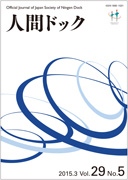Volume 29, Issue 5
Displaying 1-11 of 11 articles from this issue
- |<
- <
- 1
- >
- >|
Foreword
-
2015 Volume 29 Issue 5 Pages 679-680
Published: 2015
Released on J-STAGE: June 29, 2015
Download PDF (322K)
Review
-
2015 Volume 29 Issue 5 Pages 681-687
Published: 2015
Released on J-STAGE: June 29, 2015
Download PDF (1064K)
Original Articles
-
2015 Volume 29 Issue 5 Pages 688-693
Published: 2015
Released on J-STAGE: June 29, 2015
Download PDF (765K) -
2015 Volume 29 Issue 5 Pages 694-701
Published: 2015
Released on J-STAGE: June 29, 2015
Download PDF (994K) -
2015 Volume 29 Issue 5 Pages 702-707
Published: 2015
Released on J-STAGE: June 29, 2015
Download PDF (726K) -
2015 Volume 29 Issue 5 Pages 708-715
Published: 2015
Released on J-STAGE: June 29, 2015
Download PDF (909K) -
2015 Volume 29 Issue 5 Pages 716-722
Published: 2015
Released on J-STAGE: June 29, 2015
Download PDF (835K) -
2015 Volume 29 Issue 5 Pages 723-730
Published: 2015
Released on J-STAGE: June 29, 2015
Download PDF (1127K) -
2015 Volume 29 Issue 5 Pages 731-736
Published: 2015
Released on J-STAGE: June 29, 2015
Download PDF (821K)
Case Report
-
2015 Volume 29 Issue 5 Pages 737-741
Published: 2015
Released on J-STAGE: June 29, 2015
Download PDF (1910K)
Report
-
2015 Volume 29 Issue 5 Pages 742-751
Published: 2015
Released on J-STAGE: June 29, 2015
Download PDF (1040K)
- |<
- <
- 1
- >
- >|
